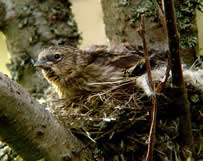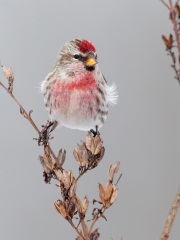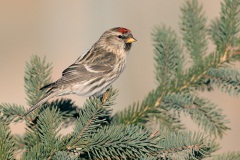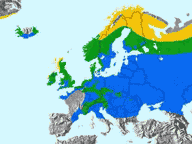| Scientific classification | ||||||||||||
|
||||||||||||
| Species | ||||||||||||
| Carduelis flammea Carduelis cabaret Carduelis hornemanni Carduelis exipilis Carduelis rostrata |
© Jacob Spendelow |
 |
cock feeds his chicks |
 |
Juvenil |
Chart |
The relatives |
Arctic Redpoll (Acanthis f. hornemanni) |
 |
Hoary redpoll (Acanthis f. exipilis) |
Lesser redpoll (Acanthis f. cabaret) |
The redpoll belongs to the genus of siskins. A closely related species, the hoary redpoll (A.hornemanni), is equal in size, but distinguished in color by the conspicuously white rump and the brighter upper and underside.Some ornithologists see the hoary redpoll as subspecies of flammea. Broader subspecies's are: A. f. cabaret, also called alpine redpoll (British islands and Alps), A. rostrata p., (Greenland). The nominate form has bright red coloration on the forehead and a black chin. The male shows bright red at the chest too, otherwise greyish brown. The female has only weak red trace, if at all, on the chest. The Alpine redpoll is smaller and browner. Distribution: Length: 12 cm -- 15 cm depending
on subspecies, weight 14 g . male:
Redpolls like to build their nest on a "nesting block" (Sabelscher Nistklotz) or emperor-nests with evergreen jewelry. They use flax fibers to build it. Redpolls are beyond all doubt, the easiest wild birds to cultivate .Nest-building starts after the pairs are formed, mostly in April. They very frequently build her nests free-standingly but the nesting helps mentioned above are also accepted. The nest is built by the female, the male participates from time to time, too. The nest usually contains five eggs. Incubation takes 12days, and is done soley by the female. The youngsters leave the nest after 14 days. During the hatching of the eggs the female, like all other finches, is very carefully fed by the male. After the hatch, the female passes the food brought by the male on to the chicks. The male feeds the chicks as well. Unlike the literature I can confirm that the redpoll often makes to 2, rarely even 3 broods per year. The diet of this species is very similar to the goldfinch and common siskin, therefore I do not repeat it. Arctic & Hoary redpollCarduelis hornemanni / exipilis The mealy redpoll is a small finch. It is larger and paler than the very similar lesser redpoll. It is streaky brown above and whitish below with black streaks. It shows two white lines on the folded wing. It does not breed in the UK, but is a passage migrant and winter visitor, particularly to the east coast. |
||
The white-rumped forms are often classified as separate species from the striped-rumped forms. According to Wolters (1975-1982) all forms are the same species. Under this classification, three subspecies are recognized:
a. Flammea: flammea, cabaret, disruptis, rostrata.,
b.Hornemanni: hornemanni, exilipes; c.Islandica: monotypical, islandica is regarded as the transitional form between the other subspecies. The general tendency is that the feather density increases toward the Pole, and the length of the extremities, especially the legs, decreases. Among most forms we have a more or less fluxuating cross-relationship. An exact determination of the subspecies is therefore, scientifically not possible. |
160
000 breeding pairs are to be found throughout Britain but rarely south
and west of Birmingham. Source
©BirdGuides 2001 and NABU
|
 |





